Breathing techniques
Note: We are not an out of hours service. If you require non-emergency out of hours assistance please call NHS 111.

About breathing techniques
This page offers helpful information and guidance for people living with long-term lung conditions. It is designed to support you in managing your breathing symptoms more effectively, helping you feel more in control of your condition and improve your overall quality of life.
Breathing control and how to do it…
Breathing control and how to do it…
Breathing control helps you to get your breath back after or during activity.
It can help with the following:
- encourages a more “normal” breathing pattern
- uses gentle “relaxed” breathing using the lower part of your chest, with relaxation of the upper chest and shoulders
- you shouldn’t feel like you are working at breathing.
How to do breathing control:
- settle yourself into a comfortable position
- rest one hand on your lower rib cage and the other one on your lap
- relax your shoulders and upper chest
- soncentrate on letting your chest move under your hand
- feel your hand rise and fall with your chest as you breathe in and out
- think about your breath in coming in through your head and breathing out through your feet
- breathe at your own rate
- continue until your breathing is back under control
- once you are happy about doing this, try resting both hands (palm up) on your lap.
Breathing when doing physical activity ‘Blow as you go’
Breathing when doing physical activity ‘Blow as you go’
Use this technique while you are doing things than make you breathless:
- Breathe in before you make the effort. For example, before lifting a heavy bag.
- Breathe out while you’re making the effort. For example, while lifting the heavy bag.
Examples of ‘blow as you go’ could be:
- When climbing stairs, take a breath in for one step, out for two steps. If very breathless, stop on each step and take a gentle breath in and out. Breathing out through pursed lips may help.
Avoid breath holding during activities, for example, climbing stairs or bending.
Positioning
Positioning
Here are some different positions to use with breathing control.
Try them all to find out which one works best for you.
- Forward lean sitting: Sit on a chair and lean forward with both of your arms resting on your thighs, relax your wrists.
- Relaxed sitting: Sit upright on a chair with both hands resting on your lap.
- Forward lean standing: Stand leaning forward with your arms resting on a ledge or window sill.
- Backward lean standing: Lean back against a wall or closed door with your shoulders relaxed and arms resting down by your side. Place your feet about 12 inches away from the wall and slightly apart.
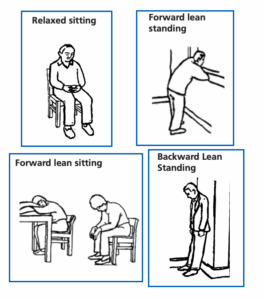
Active cycle of breathing technique (ACBT)
Active cycle of breathing technique (ACBT)
Components to ACBT
There are 3 components of ACBT:
- Breathing control (relaxed breathing)
- Deep breathing
- Huffing
It can be done in sitting or lying.
You may need to stay in position for 10 minutes before changing.
Step 1. Breathing control
Already mentioned on section above.
Step 2. Deep breathing
- Expands the chest as far as possible
- Allows air to move behind trapped sputum and loosen it to be coughed out
How to do it
- Take a slow, relaxed deep breath in, as far as you can
- Hold your breath for 3 seconds (if you can)
- Followed by a relaxed breath out
- Repeat 3 times
Step 3. Huffing
- “Pushes” the air out
- Encourages the sputum up through the airways until it can be cleared out
- If the huff is too short, it can be ineffective
- If it’s too long, it can lead to bouts of coughing
How to do it
- Take a normal breath in
- Keep your mouth open and “huff” the air out (like steaming up a mirror)
- Repeat 1 to 2 times
- Do breathing control between huffs if you feel wheezy
- When the secretions reach the bigger airways, cough the sputum out
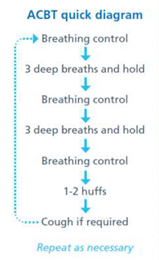
Autogenic drainage
Autogenic drainage
- Uses breathing out as far as possible to loosen sputum in the small airways
- It is then moved to the larger more central airways making it easier to cough up
- Choose a comfortable, well supported position:
- Sitting upright
- Lying down with pillows
How to do it
- Breathe in slowly, using your lower chest (as in breathing control)
- Hold your breath for 3 seconds, allowing air to evenly fill your lungs
- Push your breath out for as long as you can, keep going right to the end
- Take a slow relaxed breath in, don’t take a big breath or expand your chest as much
- Breathe out all the way again, pushing all the air out of your chest completely
- Repeat the cycle, breathe in and out slowly to avoid pushing the sputum back
- Continue until you hear or feel the sputum collecting or you feel the urge to cough
- When you need to cough, first have a “huff” and then cough
Pursed lip breathing
Pursed lip breathing
This breathing technique helps you focus, slow your breathing down and stay calm. Pursed lip breathing should be used during and after exercise. It should be used with any activity that makes you feel short of breath.
- It is breathing out through half-opened lips
- Some people do this naturally when breathless
- It helps with breathing out
- It reduces breathing rate and breathlessness
- It improves oxygen saturation and tidal volumes
- Some people find it beneficial and others don’t
To do pursed lip breathing:
- Breathe in through your nose (as if you are smelling something) for about two seconds.
- Pucker your lips like you’re getting ready to blow out candles on a birthday cake.
- Breathe out very slowly for four to six seconds.
- Repeat the steps if needed.
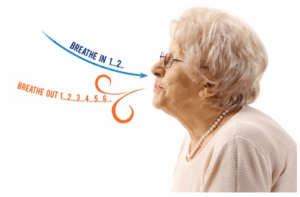
Chest clearance
Chest clearance
- It is important to clear your chest of as much sputum as possible
- Reduces obstruction
- Improves the amount of air getting through.
Breathlessness at night
Breathlessness at night
Many people suffer from breathing difficulties during the night. It can be frightening and it can increase anxiety (which makes breathlessness worse).
If you wake up breathless, try:
- sitting up over the edge of the bed, leaning forward
- keeping a fan by your bed and have it blowing on your face
- keeping your inhalers close by, take your reliever
- using breathing techniques and positioning
- DO NOT fight your breathlessness. Relax tensing muscles uses more energy making you more breathless.
Breathlessness Crisis Plan
Breathlessness Crisis Plan
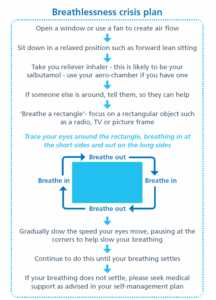
Breathlessness crisis plan
- Open a window or use a fan to create air flow
- Sit down in a relaxed position such as forward lean sitting
- Take your reliever inhaler, this is likely to be your salbultamol, use your aero-chamber if you have one
- If someone else is around, tell them, so they can help
- Breathe a rectangle, focus on a rectangular object sech as a radio, TV or picture frame (use each side to represent breathing in or out)
- Gradually slow the speed your eyes move, pausing at the corners to help slow your breathing
- Continue to do this until your breathing settles
- If your breathing does not settle, please seek medical support as advised in your self-management plan.


